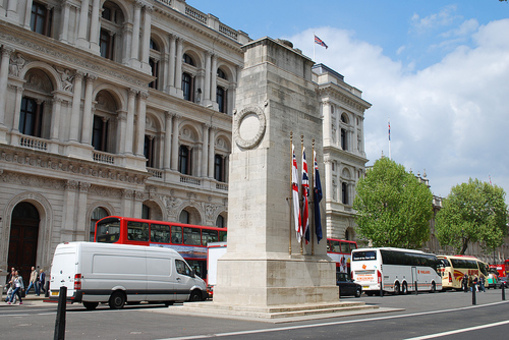
A cenotaph is a tomb or a monument erected in honour of a person or group of persons whose remains are elsewhere. It can also be the initial tomb for a person who has since been interred elsewhere. The word derives from the Greek κενοτάφιον ( kenos, one meaning being "empty", and taphos, "tomb"). Although the vast majority of cenotaphs are erected in honour of individuals, many of the best-known cenotaphs are instead dedicated to the memories of groups of individuals, such as the war dead of one country or empire.
The idea was conceived from the name of a structure in Gertrude Jekyll's garden and it replaced Lutyens's identical wood-and-plaster cenotaph erected in 1919 for the Allied Victory Parade commissioned by David Lloyd George, and is a Grade I listed building.
The "horizontal" surfaces are in fact sections of a sphere whose centre would be 900 feet (270 m) below ground.
It is undecorated save for a carved wreath on each end and the words "The Glorious Dead", chosen by Rudyard Kipling. It commemorates the victims of the First World War.It is flanked on each side by various flags of the United Kingdom which Lutyens had wanted to be carved in stone. Although Lutyens was overruled and cloth flags were used, his later Rochdale cenotaph has stone flags. In the years following 1919, the Cenotaph displayed a Union Flag, a White Ensign, and a Red Ensign on one side and a Union Flag, a White Ensign, and a Blue Ensign on the other side. On 1 April 1943, an RAF Ensign was substituted for the White Ensign on the west side of the monument. The flags displayed as of 2007 represent the Royal Navy, the British Army, the Royal Air Force, and the Merchant Navy.
The Cenotaph is the site of the annual National Service of Remembrance held at 11:00 a.m. on Remembrance Sunday, the closest Sunday to 11 November (Armistice Day).
|